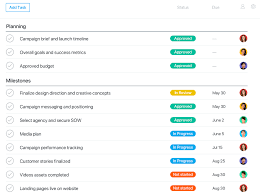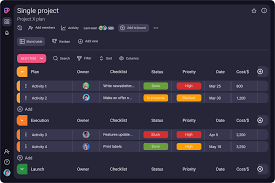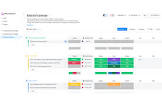Mastering Productivity: The Art of Effective Task Tracking
The Importance of Task Tracking in Productivity
Task tracking is a crucial aspect of effective time management and productivity. Whether you are a student, a professional, or simply someone trying to stay organised, keeping track of your tasks can help you prioritise, plan, and accomplish your goals efficiently.
Benefits of Task Tracking:
- Organisation: By tracking your tasks, you can create a clear overview of what needs to be done and when. This helps you stay organised and prevents important tasks from slipping through the cracks.
- Priority Setting: Task tracking allows you to identify which tasks are most urgent or important. This enables you to prioritise effectively and focus on completing high-priority tasks first.
- Time Management: Tracking your tasks helps you allocate time wisely. By estimating the time needed for each task and scheduling them accordingly, you can make better use of your time and avoid procrastination.
- Progress Monitoring: Task tracking allows you to monitor your progress towards your goals. Seeing what you have accomplished can boost motivation and provide a sense of achievement.
Tips for Effective Task Tracking:
- Use a Task Management Tool: Utilise task management tools or apps to help streamline the tracking process. These tools often offer features such as reminders, deadlines, and collaboration options.
- Break Tasks into Smaller Steps: Breaking down larger tasks into smaller, manageable steps makes them less overwhelming and easier to track progress on.
- Create Daily To-Do Lists: Start each day by creating a list of tasks to accomplish. Check off completed tasks as you go along to stay motivated.
- Review and Adjust Regularly: Regularly review your task list, adjust priorities if needed, and add or remove tasks as circumstances change.
In conclusion, task tracking is an essential tool for improving productivity and achieving success. By implementing effective task tracking strategies, you can better manage your time, stay focused on priorities, and ultimately reach your goals more efficiently.
Mastering Task Tracking: A Guide to Understanding and Implementing Effective Task Management Strategies
- What is a task tracker?
- What is an example of task management?
- What is the meaning of task tracking?
- How do you track tasks in a project?
- How do I track my tasks?
- What is the best way to track work tasks?
What is a task tracker?
A task tracker is a software tool or system designed to help individuals or teams manage and monitor their tasks, projects, and deadlines effectively. It serves as a centralised platform where users can create, assign, track, and update tasks in real-time. Task trackers often include features such as task categorisation, prioritisation, progress tracking, reminders, and collaboration tools to streamline workflow and enhance productivity. By using a task tracker, users can gain better visibility into their workload, stay organised, and ensure that tasks are completed in a timely manner.
What is an example of task management?
An example of task management is using a digital project management tool like Trello. Trello allows users to create boards for different projects, where tasks are represented as cards that can be moved across columns indicating their status (e.g., to-do, in progress, completed). Users can assign tasks to team members, set deadlines, add comments, and attach files to ensure smooth collaboration and progress tracking. This visual and interactive approach to task management makes it easy to stay organised, prioritise effectively, and monitor the status of tasks in real-time.
What is the meaning of task tracking?
Task tracking refers to the practice of monitoring and managing the progress of tasks or activities within a project or personal workflow. It involves keeping a record of tasks, including their status, deadlines, priorities, and any relevant details. By tracking tasks, individuals and teams can gain visibility into what needs to be done, when it needs to be completed, and how much progress has been made. Task tracking is essential for effective time management, prioritisation, and ensuring that goals are achieved in a timely manner.
How do you track tasks in a project?
Tracking tasks in a project involves establishing a systematic approach to monitor and manage the progress of various activities towards the project’s completion. One common method is to create a detailed task list outlining all the activities required to achieve project goals. Assigning deadlines, priorities, and responsible team members to each task helps in tracking their status and ensuring timely completion. Utilising project management tools like Gantt charts, Kanban boards, or task management software can provide visual representations of tasks, dependencies, and timelines, facilitating effective tracking and coordination among team members. Regular updates, progress reports, and meetings also play a vital role in monitoring task status and addressing any issues or delays promptly to keep the project on track.
How do I track my tasks?
Tracking tasks effectively is a common concern for many individuals seeking to enhance their productivity. To track your tasks efficiently, start by identifying a method that suits your preferences and workflow. Utilising task management tools or apps can streamline the process, offering features like reminders, deadlines, and collaboration options. Breaking down tasks into smaller, manageable steps can make tracking progress easier. Creating daily to-do lists and regularly reviewing and adjusting them ensures that you stay on top of your tasks and priorities. Experiment with different approaches until you find a tracking method that works best for you and helps you stay organised and focused on achieving your goals.
What is the best way to track work tasks?
When it comes to tracking work tasks effectively, the best way often depends on individual preferences and work requirements. However, a popular and efficient method is to use a digital task management tool or app that allows for easy organisation, prioritisation, and monitoring of tasks. These tools typically offer features such as task categorisation, deadlines, reminders, and collaboration options, making it easier to stay on top of work responsibilities. Additionally, breaking down tasks into smaller steps, creating daily to-do lists, and regularly reviewing and adjusting task priorities can further enhance the effectiveness of task tracking in ensuring productivity and goal achievement.





